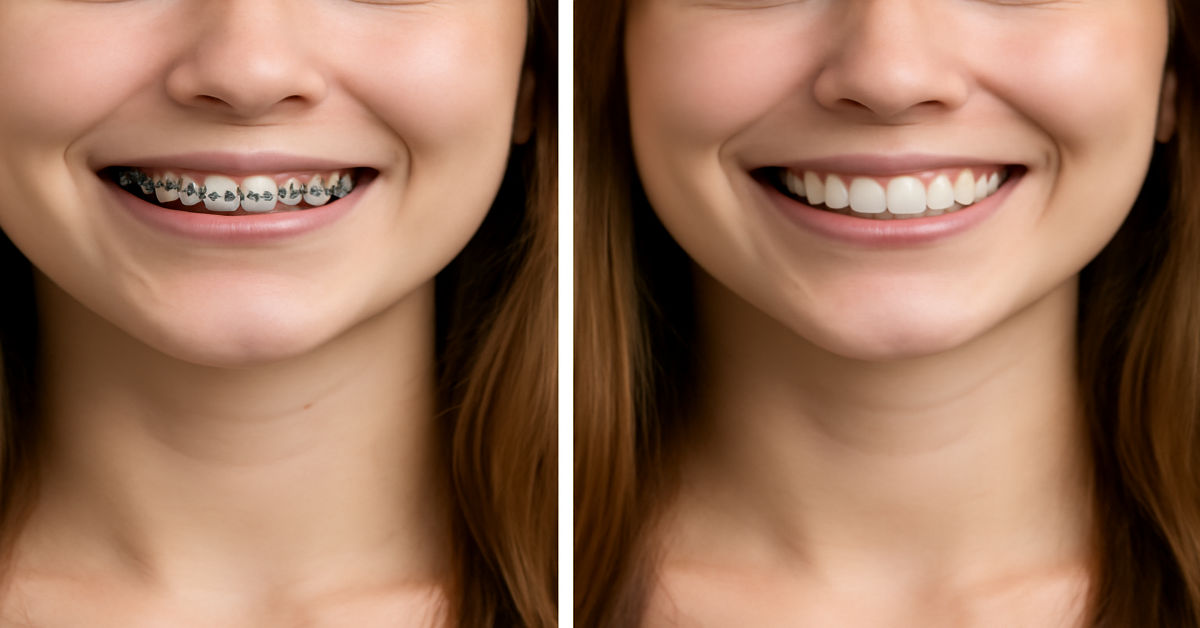When it comes to achieving a confident radiant smile braces have long been one of the most effective orthodontic treatments. Whether you’re dealing with crooked teeth, overcrowding, gaps, or bite issues, braces can dramatically transform your oral health and appearance. In this article, we’ll explore everything you need to know about braces before and after — from what to expect during the treatment process to real-world benefits and stunning smile transformations.
Understanding Braces: What Are They?
Braces are dental devices used to correct alignment issues with teeth and jaws. They consist of brackets, wires, and bands that apply gentle, continuous pressure to move teeth into their desired positions. This process not only improves aesthetics but also enhances oral function.
Why People Get Braces: Common Problems Treated
- Crowded or crooked teeth
- Gaps between teeth
- Overbite, underbite, and crossbite
- Misaligned jaws
- Speech and chewing difficulties caused by improper alignment
Each case is unique, but the goal remains the same: healthier teeth and a more attractive smile.
Braces Before: The Starting Point
Before getting braces, most patients undergo a detailed orthodontic evaluation. This typically involves:
- Dental X-rays
- Photographs of the teeth and face
- Impressions or 3D scans of the teeth
These diagnostics help orthodontists develop a personalized treatment plan.
Before braces: Patients often struggle with:
- Self-consciousness due to crooked or spaced teeth
- Difficulty cleaning teeth properly, leading to increased risk of cavities or gum disease
- Discomfort while chewing or speaking
The Braces Treatment Journey
Getting braces can feel overwhelming, especially at first. Here’s what to expect during the treatment:
- Initial Fitting: Brackets are bonded to teeth, and archwires are placed to apply pressure. This process typically takes about 1-2 hours.
- Adjustment Visits: Every 4-8 weeks, patients visit their orthodontist for wire tightening and adjustments.
- Oral Hygiene Maintenance: Braces require diligent brushing and flossing to prevent plaque buildup.
- Possible Discomfort: Mild soreness is common after adjustments but usually subsides within a few days.
The treatment length varies depending on the severity of the case but generally ranges from 12 to 36 months.
Braces After: The Transformation
The most exciting part of any braces journey is the transformation after treatment. The before and after images reveal striking improvements such as:
- Straightened teeth with perfect alignment
- Closed gaps between teeth
- Corrected bite for better chewing and speech
- Enhanced facial symmetry and confidence
Patients often report feeling more confident smiling and interacting socially. Additionally, properly aligned teeth are easier to clean and maintain, contributing to long-term oral health.
Real Patient Stories: The Impact of Braces
Case Study 1: From Crooked to Confident
Sarah, a 16-year-old high school student, had severely crowded teeth and was hesitant to smile. After 18 months of wearing metal braces, her smile transformed dramatically. Sarah now enjoys better oral hygiene and feels more self-assured in photos and social settings.
Case Study 2: Closing Gaps and Boosting Self-Esteem
John, a 28-year-old professional, had noticeable gaps between his front teeth that made him self-conscious. After two years with ceramic braces, his teeth are perfectly aligned, boosting his self-esteem and even improving his speech clarity.
Types of Braces: Options to Suit Your Needs
Today’s braces come in various types, offering options based on aesthetics, comfort, and budget:
- Metal Braces: The traditional and most common type, known for durability.
- Ceramic Braces: Tooth-colored brackets that blend in with natural teeth.
- Lingual Braces: Placed behind the teeth, invisible from the front.
- Clear Aligners: Removable, transparent trays like Invisalign, suitable for mild to moderate corrections.
Your orthodontist can help determine the best type based on your specific case.
Benefits Beyond Appearance
While the visual transformation is undeniable, braces offer many other important benefits:
- Improved oral health: Straight teeth are easier to clean, reducing cavities and gum disease.
- Better bite function: Correct alignment prevents uneven wear and jaw pain.
- Speech improvements: Misaligned teeth can affect pronunciation; brace’s help correct this.
- Long-term dental savings: Properly aligned teeth reduce the risk of costly dental problems later in life.
Maintaining Your Smile After Braces
Once the brace’s come off, the journey isn’t over. Retainers are essential to maintain your new smile by preventing teeth from shifting back to their original positions. Your orthodontist will provide guidance on how long to wear retainers, often starting with full-time wear and transitioning to nighttime use.
Braces Before and After Photos: Why They Matter
Seeing brace’s before and after photos is incredibly motivating for many considering orthodontic treatment. These images:
- Show realistic results and set expectations
- Highlight the transformative power of brace’s
- Help patients understand the commitment required
- Inspire confidence in choosing treatment
Orthodontists often showcase these photos on their websites or offices to educate and encourage prospective patients.
Tips for a Successful Braces Experience
- Maintain excellent oral hygiene: Use special orthodontic brushes and floss to keep teeth clean.
- Avoid hard, sticky, or sugary foods: These can damage brace’s and increase the risk of cavities.
- Attend all adjustment appointments: Regular check-ups ensure steady progress.
- Communicate any discomfort: Your orthodontist can make adjustments to reduce pain or irritation.
- Follow retainer instructions: Retainers preserve your hard-earned results.
Common Myths About Braces
- Braces are only for kids: Adults can also benefit significantly from orthodontic treatment.
- Braces are painful: While some discomfort is normal, modern brace’s are more comfortable than ever.
- Treatment takes forever: Treatment time varies, but many see results in under two years.
- Braces damage teeth: When cared for properly, brace’s improve overall dental health.
Final Thoughts: The Power of Braces Before and After
Brace’s do more than straighten teeth — they transform lives. The journey from “before” to “after” is a testament to modern dental technology, patient commitment, and professional care. Whether you’re a teenager or adult, considering brace’s can open the door to a healthier, more confident smile.
If you’re ready to explore orthodontic treatment, consult a qualified orthodontist who can tailor a plan to your needs and help you achieve the smile you deserve.
FAQs About Braces Before and After
1. How long does it typically take to see results with brace’s?
Most patients start noticing changes within a few months, but full treatment usually ranges from 12 to 36 months depending on the complexity of the case.
2. Are brace’s painful during the adjustment period?
Some mild discomfort or soreness is common after adjustments, but it typically lasts only a few days and can be managed with over-the-counter pain relievers.
3. Can adults get brace’s as effectively as teenagers?
Yes! Adults of all ages can benefit from braces, and many orthodontic options are designed with adult lifestyles in mind.
4. What is the difference between traditional brace’s and clear aligners?
Traditional brace’s use brackets and wires fixed to teeth, while clear aligners are removable trays. Aligners are less visible but may not be suitable for all cases.
5. How important are retainers after brace’s?
Retainers are crucial to keep teeth in their new position after brace’s are removed. Without them, teeth can gradually shift back, undoing the treatment progress.











